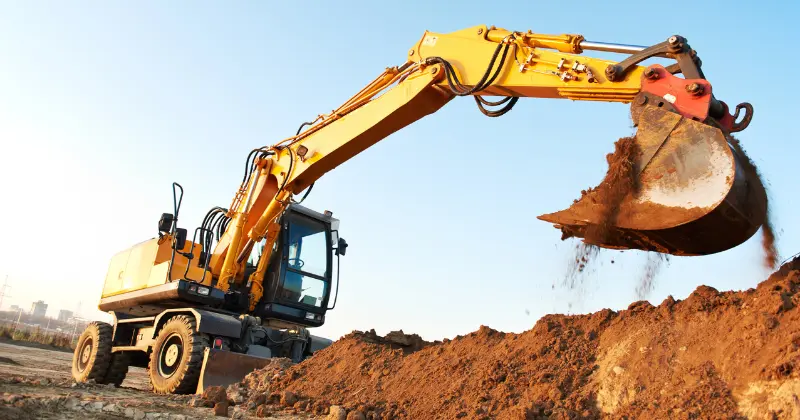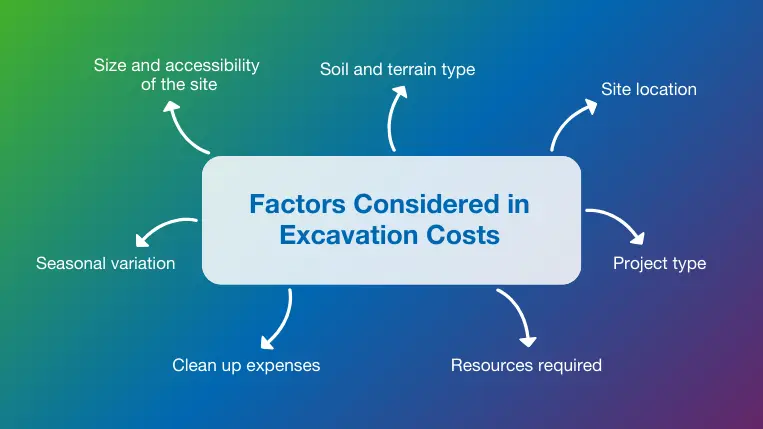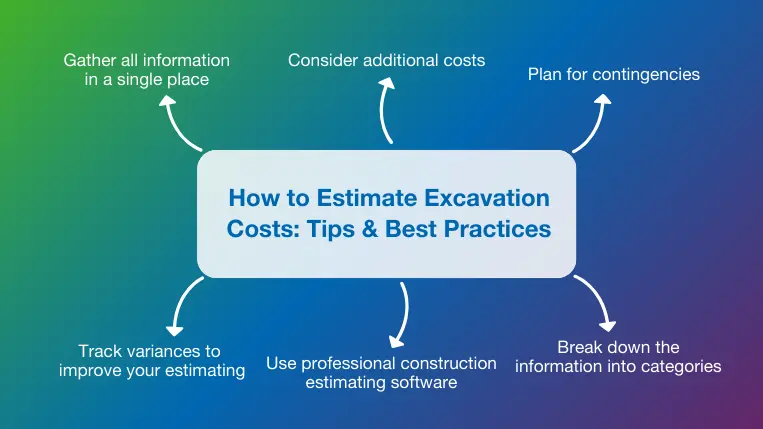11 mins read
Excavation Costs: Tips and Best Practices to Successfully Estimate Excavation Expenses

Excavation is one of the last essential tasks performed before construction crews begin to bring a new building to life. Depending on the terrain, project scope, and existing soil and vegetation, excavation costs can vary significantly. Budgets and schedules can be unexpectedly impacted when specialized equipment and labor increase excavation cost and complexity.
Keep reading to learn everything about excavation costs!
What Is Land Excavation?
Land excavation is the process of removing unwanted soil, rock, and other materials to prepare a site for construction. Excavation processes typically utilize heavy equipment like bulldozers and backhoes to dig into the ground and transport materials accordingly.
Excavation services are frequently required for major construction projects, renovations, and small residential tasks like swimming pools or water pipe installations. Building foundations, roads, and tunnels are among the undertakings that are likely to require excavation work such as trenching, clearing, and material removal to be completed before beginning important grading and leveling tasks.
How Much Does Excavation Cost?
As a rule of thumb, excavation costs are proportional to the amount of material or soil moved, ranging from $50 to $200 USD for each cubic yard of cultivated land. This means small projects like swimming pools and landscaping jobs cost significantly less than basement renovations, large rock removal tasks, or new construction preparation that can exceed $20,000 USD. The combination of skilled labor, time, and machinery involved makes it important to understand how to estimate excavation costs.
Factors Considered in Excavation Costs

Excavation may sound like a straightforward and predictable process, but the variable conditions and circumstances can make estimating excavation costs a challenging endeavor. Along with the standard labor or volume-based rates and the availability of local crews and equipment, many other factors directly impact these expenses.
Size and accessibility of the site
The size of the site and project scope are obvious factors since a large trench spanning several acres is different from a residential sprinkler installation. A full-sized excavator costs about 50% more to rent than a small backhoe and also requires more highly trained (and expensive) labor to operate. Accessibility can also impact land excavation costs when hard-to-reach areas and tight spaces call for specialized tools and equipment or inadequate entry points eliminate some standard equipment options.
Soil and terrain type
Most construction sites appear similar at the ground level, but the composition of the soil, especially deep underground, can vary tremendously. Hard, rocky soil, boulders, and clay deposits lead to additional building excavation costs, depending on the composition, depth of excavation, precision of work required, etc. This makes advanced preparation through construction site surveying, soil sampling, lab testing, or ground-penetrating radar (GPR) useful for assessing the terrain proactively.
Site location
Moving heavy equipment to and from remote locations increases land excavation costs tied to time and fuel, but there are other important considerations related to site location. For example, urban areas are usually much more accessible but may have restrictions on noise, road use, and hours of operation. Each region will vary somewhat in the average cost of local excavation teams.
Environmental laws and restrictions also vary by area, which makes it important to research the relevance of these requirements ahead of time. Weather patterns and the availability of local workers are other regional variables that should be investigated in advance.
Project type
The type of construction project is another huge factor in determining excavation rates. Complex, unusual, or dangerous projects might require specialized equipment and labor. For example, an in-ground swimming pool excavation is a relatively predictable task that can cost as little as $400-$1500 in the US, while extensive land clearing might cost 3 or 4 times as much. These residential tasks pale compared to large-scale industrial excavation efforts with expansive budgets and timelines.
Resources required
The resources involved in excavation include the labor and equipment needed to complete the task, along with complementary items such as fuel, safety equipment, fencing, and water pumps. Equipment and labor resources contribute the most cost, with typical hourly rates for residential excavation labor running from $120 to $150 per hour.
The costs associated with equipment usage and operation are typically proportional to the original cost of the equipment itself. For this reason, projects that can be completed with standard bulldozers, augers, and light-duty excavators require fewer resources than those requiring heavy-duty mining shovels or trenchers.
Cleanup expenses
The cost of cleaning up the site after excavation can vary significantly and sometimes isn’t fully understood until most of the work has been completed. Cleanup processes include removing and transferring materials to landfills or recycling facilities, along with minor site restoration and erosion control tasks. The total cost of cleanup also includes relatively inexpensive soil contamination tests. These routine tests can lead to more extensive (and expensive) cleanup activities in cases where hazardous or volatile substances are detected, and more material removal is necessary.
Seasonal variation
Weather conditions are also a serious consideration when estimating excavation costs since digging, trenching, and earth removal processes can be brought to a standstill when the ground is frozen solid or rain threatens to wash out newly created trenches, cavities, and tunnels. These adverse conditions may result in higher labor and equipment costs in winter, although high demand can also drive rates up in the summer and spring.
How to Estimate Excavation Costs: Tips & Best Practices

Carefully evaluating factors like the location, required resources, and terrain is essential. Still, as you learn how to calculate excavation costs accurately, you must develop strategies and deploy construction software solutions to streamline the excavation estimating process. Below are valuable tips to succeed.
1. Gather all information in a single place
Accurate excavation estimates require a wide variety of inputs, including information on the soil composition and excavation depth, site drawings and plans, and labor and equipment rates based on the location and time of year in which the work is expected to take place. Professional construction collaboration software is extremely helpful for organizing, analyzing, and sharing this information with other stakeholders, ensuring a single source of truth for all project data.
2. Consider additional costs
Estimating excavation costs means reviewing all potential tasks or changes that might impact the scope and duration of work, no matter how minor, insignificant, or unlikely they may seem. Additional costs and fees that might be incurred during excavation include:
- Consulting fees for unique engineering problems
- Backfill materials like gravel to maintain site stability
- Environmental permits and application fees
- Liability and worker’s compensation insurance
3. Plan for contingencies
A contingency is a percentage of a project’s budget that is set aside for unforeseen expenses. Common construction contingencies include inclement weather, overtime costs, rework expenses, labor issues, and many other factors directly impacting excavation costs. Factoring these contingencies into the estimate helps to mitigate risks and prevent budget overruns, with appropriate dollar amounts allocated to address the unknown.
4. Break down the information into categories
There are many different categories of building excavation costs, including labor, equipment, soil testing, insurance, erosion control, and transportation. Organizing costs into these distinct buckets is a valuable practice that supports detailed bids, estimates, and schedules in the early stages of the project. Once excavation work is underway, categorized and timely cost and expense data make it easier to track progress, report to stakeholders, and detect overruns quickly.
5. Use professional construction estimating software
The best quantity takeoff and estimating software tools support accurate and efficient excavation cost determination with access to up-to-date cost databases, customized templates for estimates and reports, and direct takeoff capabilities using 2D or 3D drawing inputs. RIB CostX is an integrated takeoff, estimating, and reporting tool that allows quantity surveyors and construction estimators to manage large amounts of data while avoiding costly errors. CostX also provides advanced revision tracking, embodied carbon calculations, and convenient subcontractor comparisons to ensure success across the board.
6. Track variances to improve your estimating
Variances, or the difference between estimated and actual costs, help to pinpoint areas where excavation costs were either underestimated or overestimated due to inadequate information, unforeseen events, or changes to the scope of work or site conditions. Tracking variances with a construction reporting system carefully helps to balance project value with expenditures on current excavation projects. This information also makes it easier to baseline and predict future labor, equipment, material costs, and contingencies and create timelines based on experience rather than guesswork.
Conclusion
Excavation takes on added importance when considering the breadth of preparation and planning required at or below ground level to guarantee a successful outcome above ground. Professional solutions, like CostX estimating software, are invaluable for collecting, organizing, analyzing, and reporting excavation information and creating estimates quickly and accurately. Along with advanced takeoff and estimating features, RIB CostX offers valuable functionalities for collaboration, document management, and carbon accounting, ensuring estimating data can be integrated with all other information for effective decision-making.
If you are ready to streamline the estimating process and ensure your excavation projects are priced accurately, get your free demo for RIB CostX today!
Get My Free RIB CostX Demo Now

Most Recent
11 mins read
10 mins read
10 mins read
29 mins read
Blog Categories

Ebook











